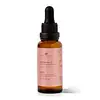What's inside
What's inside
 Key Ingredients
Key Ingredients

 Benefits
Benefits

 Ingredients Side-by-side
Ingredients Side-by-side

Water
Skin ConditioningGlycerin
Humectant3-Glyceryl Ascorbate
AntioxidantSodium Hyaluronate
HumectantFerulic Acid
AntimicrobialTocopheryl Acetate
AntioxidantSimmondsia Chinensis Seed Oil
EmollientCitrus Aurantium Dulcis Peel Oil
MaskingOlive Oil Glycereth-8 Esters
EmollientAloe Barbadensis Leaf Juice Powder
Skin ConditioningPhenoxyethanol
PreservativeXanthan Gum
EmulsifyingEthylhexylglycerin
Skin ConditioningSodium Citrate
BufferingCitric Acid
BufferingSodium Phytate
Water, Glycerin, 3-Glyceryl Ascorbate, Sodium Hyaluronate, Ferulic Acid, Tocopheryl Acetate, Simmondsia Chinensis Seed Oil, Citrus Aurantium Dulcis Peel Oil, Olive Oil Glycereth-8 Esters, Aloe Barbadensis Leaf Juice Powder, Phenoxyethanol, Xanthan Gum, Ethylhexylglycerin, Sodium Citrate, Citric Acid, Sodium Phytate
Aloe Barbadensis Leaf Juice
Skin ConditioningAscorbic Acid 15%
AntioxidantGlycerin
HumectantBellis Perennis Flower Extract
Skin ConditioningHeptyl Glucoside
Sodium Hyaluronate
HumectantSodium Citrate
BufferingTocopheryl Acetate
AntioxidantPrunus Armeniaca Kernel Oil
MaskingTerminalia Ferdinandiana Fruit Extract
AntioxidantCalendula Officinalis Flower Oil
MaskingCitrus Nobilis Oil
MaskingHibiscus Esculentus Fruit Extract
Skin ConditioningLevulinic Acid
PerfumingXanthan Gum
EmulsifyingSodium Phytate
Erythritol
HumectantAloe Barbadensis Leaf Juice, Ascorbic Acid 15%, Glycerin, Bellis Perennis Flower Extract, Heptyl Glucoside, Sodium Hyaluronate, Sodium Citrate, Tocopheryl Acetate, Prunus Armeniaca Kernel Oil, Terminalia Ferdinandiana Fruit Extract, Calendula Officinalis Flower Oil, Citrus Nobilis Oil, Hibiscus Esculentus Fruit Extract, Levulinic Acid, Xanthan Gum, Sodium Phytate, Erythritol
Ingredients Explained
These ingredients are found in both products.
Ingredients higher up in an ingredient list are typically present in a larger amount.
Glycerin is already naturally found in your skin. It helps moisturize and protect your skin.
A study from 2016 found glycerin to be more effective as a humectant than AHAs and hyaluronic acid.
As a humectant, it helps the skin stay hydrated by pulling moisture to your skin. The low molecular weight of glycerin allows it to pull moisture into the deeper layers of your skin.
Hydrated skin improves your skin barrier; Your skin barrier helps protect against irritants and bacteria.
Glycerin has also been found to have antimicrobial and antiviral properties. Due to these properties, glycerin is often used in wound and burn treatments.
In cosmetics, glycerin is usually derived from plants such as soybean or palm. However, it can also be sourced from animals, such as tallow or animal fat.
This ingredient is organic, colorless, odorless, and non-toxic.
Glycerin is the name for this ingredient in American English. British English uses Glycerol/Glycerine.
Learn more about GlycerinSodium Citrate is the sodium salts of citric acid. In skincare, it is used to alter pH levels and acts as a preservative.
Its main functions are to maintain the pH of a product and neutralize metal ions.
The acidity of our skin is maintained by our glands and skin biome; normal pH level of skin is slightly acidic (~4.75-5.5).
Being slightly acidic allows our skin to create an "acid mantle". This acid mantle is a thin barrier that protects our skin from bacteria and contaminants.
Learn more about Sodium CitrateSodium Hyaluronate is hyaluronic acid's salt form. It is commonly derived from the sodium salt of hyaluronic acid.
Like hyaluronic acid, it is great at holding water and acts as a humectant. This makes it a great skin hydrating ingredient.
Sodium Hyaluronate is naturally occurring in our bodies and is mostly found in eye fluid and joints.
These are some other common types of Hyaluronic Acid:
Learn more about Sodium HyaluronateSodium Phytate is the synthetic salt form of phytic acid. Phytic acid is an antioxidant and can be found in plant seeds.
Sodium Phytate is a chelating agent. Chelating agents help prevent metals from binding to water. This helps stabilize the ingredients and the product.
Tocopheryl Acetate is AKA Vitamin E. It is an antioxidant and protects your skin from free radicals. Free radicals damage the skin by breaking down collagen.
One study found using Tocopheryl Acetate with Vitamin C decreased the number of sunburned cells.
Tocopheryl Acetate is commonly found in both skincare and dietary supplements.
Learn more about Tocopheryl AcetateXanthan gum is used as a stabilizer and thickener within cosmetic products. It helps give products a sticky, thick feeling - preventing them from being too runny.
On the technical side of things, xanthan gum is a polysaccharide - a combination consisting of multiple sugar molecules bonded together.
Xanthan gum is a pretty common and great ingredient. It is a natural, non-toxic, non-irritating ingredient that is also commonly used in food products.
Learn more about Xanthan Gum